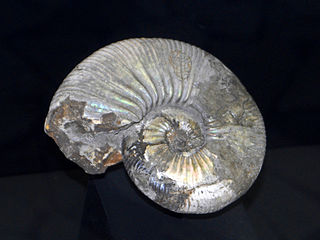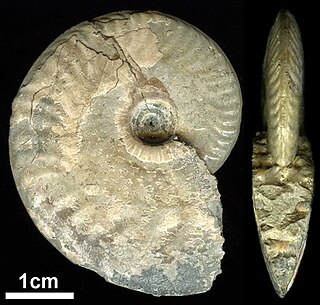
Ammonoids are a group of extinct marine mollusc animals in the subclass Ammonoidea of the class Cephalopoda. These molluscs, commonly referred to as ammonites, are more closely related to living coleoids than they are to shelled nautiloids such as the living Nautilus species. The earliest ammonites appeared during the Devonian, with the last species vanishing during or soon after the Cretaceous–Paleogene extinction event.

Goniatites is a genus of extinct cephalopods belonging to the family Goniatitidae, included in the superfamily Goniatitaceae. Hibernicoceras and Hypergoniatites are among related genera.

Ammonitida is an order of ammonoid cephalopods that lived from the Jurassic through Paleocene time periods, commonly with intricate ammonitic sutures.

Cypraeoidea, the cowries and cowry allies, is a superfamily of sea snails, marine gastropods included in the clade Littorinimorpha. This superfamily had been called Cypraeacea and was named by Rafinesque in 1815.
Abbasites is an extinct genus of ammonites from the early Middle Jurassic epoch, included in the ammonitid family Erycitidae.

Acanthohoplites is an extinct genus of ammonites in the family Parahoplitidae that lived in the Aptian and Early Albian stages of the Early Cretaceous.

Aspidoceras is an extinct ammonoid cephalopod genus belonging to the family Aspidoceratidae.

Arnioceras is an extinct genus of large, evolute, discoidal ammonite from the Lower Jurassic. The shell is normally coiled so that all whorls are exposed. Sides bear strong sharp ribs that are straight until reaching the ventrolateral edge where they swing forward and fade. The rim (venter) is keeled and free of grooves.
Balearites is an extinct ancyloceratin genus included in the family Crioceratitidae, subclass Ammonoidea, from the Upper Hauterivian.
Beudanticeras is an extinct cephalopod genus from the Late Cretaceous period; Albian and Cenomanian, belonging to the ammonoid subclass and included in the family Desmoceratidae.
Uhligella is an extinct cephalopod genus from the Early Cretaceous, belonging to the ammonoid subclass and included in the Desmoceratidae.

Goniatitina is one of two suborders included in the order Goniatitida; extinct Paleozoic ammonoid cephalopods only distantly related to the Nautiloidea.
Dimeroceratidae is one of three families in the Dimeroceratoidea, a goniatid superfamily included in the Ammonoidea; extinct shelled cephalopods with adorally convex septa and usually narrow ventro-marginal siphuncles.

Acanthoceratoidea, formerly Acanthocerataceae, is a superfamily of Upper Cretaceous ammonoid cephalopods belonging to the order Ammonitida, and comprising some 10 or so families.
Lecanites is a ceratitid genus assigned to the Danubitaceae, with an essentially smooth, evolute, discoidal shell and a goniatitic suture with many elements. It is the type and now only genus of the Lecanitidae.

Oppeliidae are compressed to oxyconic, sculptured Haploceratoidea, either unkeeled, unicarinate, bicarinate, or tricarinate; with sutures in great variety, but ribbing usually more or less falcoid or falcate. The Oppeliidae is the principal family of the Haploceratoidea, with the longest duration, extending from the Middle Jurassic (Bajocian) to the Upper Cretaceous (Cenomanian) Their derivation is from the Hildoceratoidea.

Menuites is a genus of extinct ammonites, forming a rather small offshoot of Anapachydiscus with a fairly widespread distribution from the Upper Cretaceous Santonian and Campanian stages.

Kepplerites is a moderately evolute ammonite from the lower Callovian included in the Stephanoceratoidea.

Macroscaphites is an extinct cephalopod genus included in the Ammonoidea that lived during the Barremian and Aptian stages of the Early Cretaceous. Its fossils have been found throughout most of Europe and North Africa.

Dufrenoyia is an extinct genus of Cretaceous ammonites included in the family Parahoplitidae. These fast-moving nektonic carnivores lived in the Cretaceous period. The type species of the genus is Ammonites dufrenoyi.













